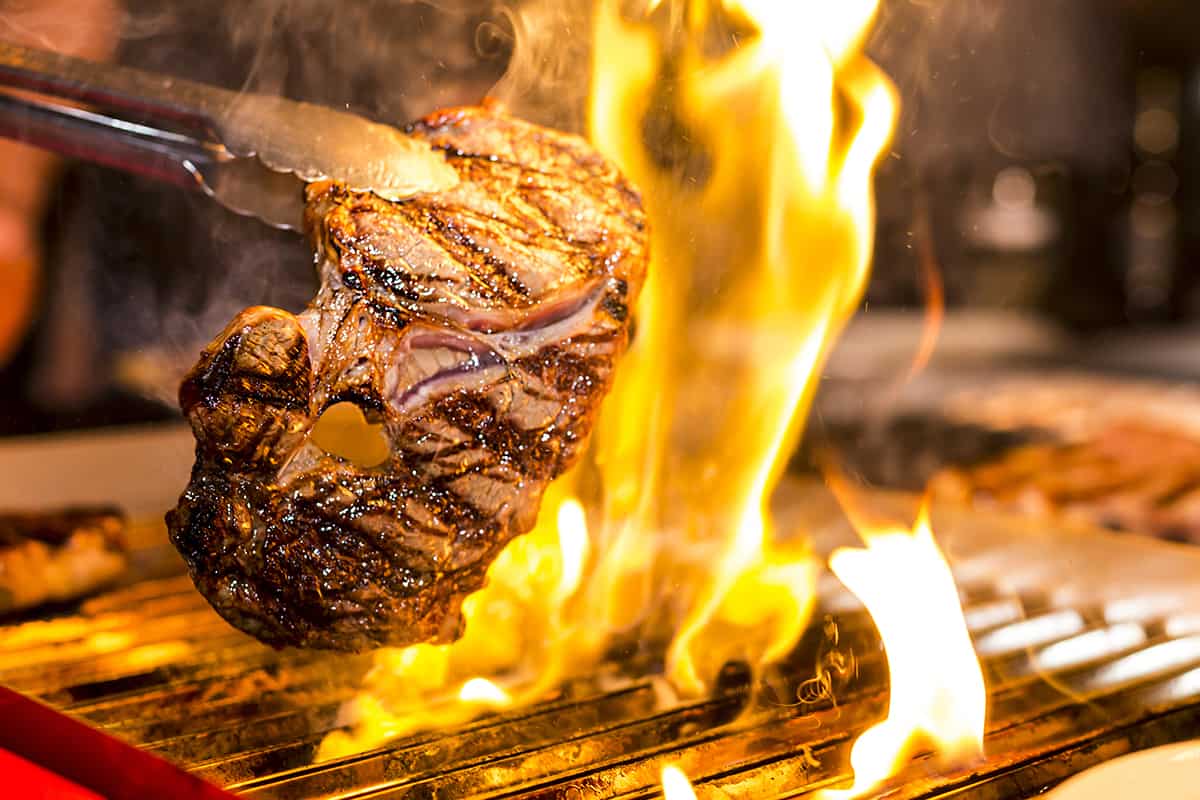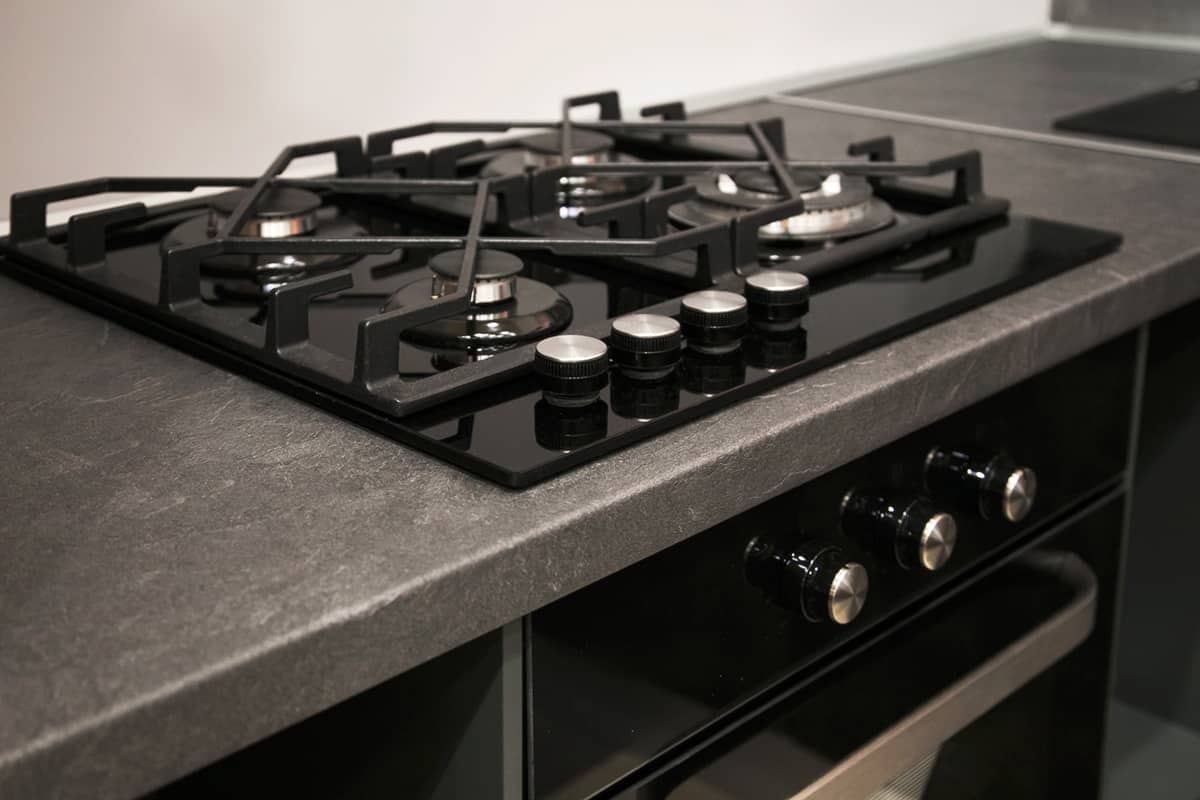Broiling is a cooking method that involves placing food underneath a direct flame. The purpose is to crisp or caramelize the top, adding a contrast of texture to a recipe. But since flames come from the bottom of a gas oven, so is it possible to broil using a gas oven?
Gas ovens have a separate broiling compartment found at the bottom of the oven. The flames from beneath the oven’s floor will heat the top of the broiling pan. Underneath the pan is a drip tray to capture runoff.
In this guide, I’ll explain how to use the broiler on a gas oven, as well as common broiling mistakes and how to avoid them.
What Is Broiling?
Broiling is a method of cooking that involves exposing food to direct heat from above. It differs from grilling since the food comes into direct contact with an open fire from below, and there are grates that affect the food’s texture.
The main goal of broiling isn’t to cook food to completion but rather to crisp the tops of food. Broiling involves using super-high temperatures—upwards of 500°F—to rapidly affect the surface of the food. As such, food can become overcooked or burned to a char when left under the broiler for too long. At most, you should broil your food for 5 minutes before moving it to a serving platter.
What Foods Can You Broil?

While broiling can be used for any food, there are specific dishes you want to avoid from broilings, such as eggs, cakes, and anything else you don’t want to crisp up. If you’re new to the broiling game, you can enhance the following food items’ flavors and textures by broiling them for a few minutes.
Casseroles
If you want to add a crispy top to your casseroles, mix butter and brown crumbs together, pour the mix on top of your casserole, then place the casserole dish under the broiler for 1 to 2 minutes. Alternatively, you can make your mac and cheeses extra cheesy by broiling a layer of mozzarella and cheddar cheese on top of the dish.
Pizzas
If your oven isn’t hot enough to give the crust of your pizzas a golden-brown finish, move the pizza to the broiler and let the direct flames do the work for you.
Crème Brûlée
After the custard has set, transfer your crème brûlée to the broiler. Don’t forget to add a layer of granulated sugar on top for an extra crunch!
Vegetables
Don’t have enough time to roast your veggies in the oven? Just place a bunch of your favorite non-leafy vegetables in a broiling pan and let the broiler crisp them right up. Make sure to flip the veggies halfway through to get them extra roasted and crunchy.
Steaks and Fillets
Pan-searing steaks are nice and all, but if you want to go the extra mile, you should broil your steaks instead. The great thing about thinly cut steaks is that you can cook them from start to finish underneath an oven’s broiler. Also, you can even cook fish fillets in under 2 minutes in the broiler and retain their flakiness.
Can You Broil in a Gas Oven?
So, is it possible to broil in a gas oven? The answer is, yes, you can, but it’s a bit more complicated than it is in an electric oven.
The flames of a gas oven are located at the bottom. Heat rises from the bottom to the top of the oven to create a heated environment to bake foods. What this means is that the broiler has to be underneath those flames.
Gas ovens will come with a drawer on the bottom. When you pull the drawer out, you can access the broiling compartment. It can be a bit tricky trying to get your bakeware underneath the broiler, but it can be done.
How to Broil in a Gas Oven
Here’s how you can use a gas oven to broil food:
Look for the broiler option on the control board of your oven. You will usually have to turn the temperature dial all the way to the right—past the highest oven temperature setting—to activate the broiler function.
Allow the broiler to preheat the broiling compartment for about 10 minutes. This isn’t necessary if you want to crisp up your food. However, if you are going to bake thinly cut steaks and fish fillets in the broiler, preheating is mandatory for even cooking.
Place your food in broiler-safer cookware in the broiling compartment. Make sure to keep your hands away from the top of the baking dish since the flames are just a few inches away from the bottom of the broiling compartment.
Remove the bakeware from the broiling compartment and shut the broiler off.
Remember: it only takes a few minutes to brown the tops of casseroles, pizzas, desserts, etc. The longer you let it sit in the broiler, the likelier it will burn and have an unappetizing top layer.
Broiling in a Gas vs. Electric Oven
Broiling in a gas oven and electric oven produce equal results, assuming the broiler function in both oven types is working perfectly. So, how do they differ? Basically, one is a lot easier to use than the other.
Gas ovens have a separate broiling compartment located near the floor. It can be a pain to insert and remove food, and there’s a pretty good risk that you will burn your fingers on the flames if you’re not too careful.
Broiling is something electric ovens do extremely well. The broiler is located on the ceiling of the oven’s interior. So, to broil casseroles, pizzas, veggies, etc., all you have to do is transfer the dish to the topmost oven rack.
The greatest thing about broilers in electric ovens is that you can adjust the distance between the top of your dish to the broiler’s flames. All you have to do is relocated the topmost rack to a lower position. By creating a wider gap between your food and the broiler’s flames, you lower the risk of your food burning in the food.
Another awesome thing is if your oven has a glass door, you can see the progress of your broiled food. This is impossible to do with a gas oven unless you pull out the broiler compartment and risk losing all of the built-up heat.
Common Broiling Mistakes and How to Avoid Them

As simple as broiling is, there are a few things you want to avoid doing.
Broiling frozen food
If you want to roast vegetables rapidly, make sure you’ve given them time to thaw. Take them out of the freezer or fridge and let them come up to room temperature. Broiling frozen food will result in a mushy exterior with an unappetizing frozen crunch.
Broiling liquids
While you can broil meats straight from a marinate, make sure you pat them dry before doing so. The oils can actually catch fire if you place them in a 500°F-plus oven. The last thing you want is to burn your kitchen down while trying to crisp up your steaks!
Using non-broiler-safe bakeware
Tempered glass is great for baking, even at super-high heat. However, it might not withstand temperatures exceeding 500°F, which is the whole point of broiling. The best thing you can do is find a broiler-safe baking dish.
Broiling thick slabs of meat
Again, broiling is mainly used to finish foods or cook thinly sliced pieces of meat and fish. There is no way you are going to finish cooking a 24-ounce steak in a broiler without charring the outside and leaving the inside blue/too rare for anyone’s liking.






